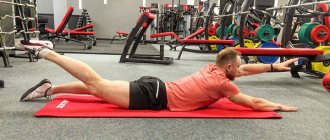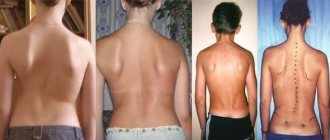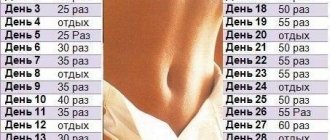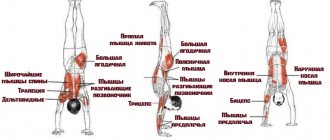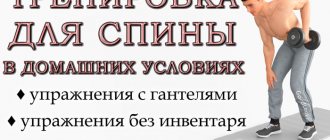What is back stretching?
Spinal stretching is a set of exercises to improve the condition of the back muscles, increasing their strength and at the same time elasticity. Its implementation has a general strengthening, tonic effect on the skeletal muscles of the entire musculoskeletal system. Stretching, or traction of the spine at home, is an important part of the treatment of diseases, including cervical, thoracic, lumbar osteochondrosis, and deforming spondyloarthrosis. Strong muscles reliably stabilize discs and vertebrae and prevent their displacement.
Why do you need to stretch your spine?
The spinal column consists of 32-34 individual vertebrae, five of which make up the lumbar region. Between each pair of vertebrae there is an intervertebral disc, and two pairs of nerve roots emerge. The lumbar region includes movable vertebrae, joints, complex connections of elements of the skeletal system and a large number of sensitive nerve endings. It protects the spinal cord from mechanical damage and bears a huge load.
- The internal muscles of the spine do not relax well after suffering stress and are often in constant tension. This leads to the fact that they lose flexibility and strength, become stiff, and movements are constrained.
- The blood supply around the “tight muscle” is disrupted.
- With constant muscle tension, the distance between the vertebrae decreases. This causes destruction of the intervertebral discs, and the roots of the spinal cord begin to experience irritation.
To reduce unpleasant symptoms and prevent more serious disorders in the lumbar spine, doctors recommend doing a set of stretching exercises.
What are the benefits of stretching for the spine?
Many spinal pathologies cannot yet be completely cured. To prevent the patient from suffering from back pain and stiffness, analgesics are prescribed. But with long-term use of drugs, their pronounced side effects appear. Therefore, doctors recommend that patients radically solve the problem by stretching the spine:
- eliminate all symptoms;
- stop the spread of the disease to healthy tissue.
Stretching increases the spaces between the discs and vertebrae. They stop squeezing blood vessels and spinal roots. And the resulting bone growths (osteophytes) no longer injure soft tissues, provoking the development of inflammation.
Indications for exercises
Stretching the back muscles can be recommended both for osteochondrosis and for its complications that have already developed - protrusion or intervertebral hernia. And spinal traction for hernial protrusions, performed by chiropractors, often avoids surgical intervention. In what cases is stretching the back muscles therapeutically effective:
- for aching, pressing, nagging pain in the cervical, thoracic, lumbar region that occurs after physical exertion, hypothermia, changes in weather;
- with morning stiffness, which disappears only after 30-40 minutes;
- with increased headaches, dizziness, tinnitus, double vision of objects in front of the eyes, indicating developing vertebral artery syndrome.
Regular stretching of the spinal muscles is necessary to prevent osteochondrosis for people at risk. The disease develops due to excess weight, prolonged stay in one body position, and excessive stress on the spine.
Three-point spinal rotations
Sometimes you need to stop movement in one area to create movement in another area. In this case we are talking about the lower back. When you are on all fours, trying to open your chest, you will find it very difficult to move, this is partly because your hips are pressed to the floor and your knees are in contact with the ground, which limits the rotational potential in your lower back.
Execution order:
- Get on all fours.
- Place one hand behind your head and rest the other on the floor.
- Turn your body as high as possible without lifting your knees from the floor.
- Repeat for the second side.
General rules for stretching
Most stretching exercises are static. This means that you do not need to make intense movements when performing them. However, a preliminary warm-up is necessary to prepare the muscles for the upcoming loads. Exercise therapy doctors advise walking around the room, raising your knees high, bending forward, backward, and turning in both directions. The following rules should also be observed:
- movements should be slightly slow;
- if painful sensations appear, training should be stopped and continued only after rest;
- When performing exercises, you should stay in the stretching position for 10-20 seconds;
- breathing should be even, deep, rhythmic.
It is not necessary to perform all the exercises at once - the load should be increased gradually. If any movement causes pleasant sensations in the back muscles, then it can be repeated in 2-3 approaches.
Fetal position with raised arm
This is another classic back mobility and activation exercise that is often overlooked for some reason. With the correct technique, the serratus muscle and lower trapezius muscle receive a better load. Moreover, the last stage, when you need to raise your arms, is difficult for some athletes and needs to be worked on.
Execution order:
- Get on all fours, put your arms slightly forward.
- Lower your buttocks onto your heels, while keeping your arms straight.
- Slowly raise and lower your arms.
Exercise equipment and devices
Rehabilitation centers are equipped with the most modern spinal traction machines. But there are devices that can be purchased in specialized stores for training at home.
Horizontal bar
Hanging on the horizontal bar is indicated for patients with protrusions or intervertebral hernias of the lumbar and thoracic region. If the cervical discs and vertebrae are damaged, this type of stretching is not used due to the high risk of muscle overstrain and deterioration of well-being. You need to hang on the horizontal bar for several minutes 3-4 times a day.
Evminov simulator
The Evminov simulator is a wide, fairly flexible pine board, equipped with several brackets or handles for holding the limbs. Typically, the exercises are performed in a lying position, face down or up. The person rests his feet on the floor and smoothly moves his body first up and then down.
Gleason loop
The Gleason loop, or traction loop, is designed to increase the distance between vertebrae and strengthen the muscles of the upper body. The device is most in demand for osteochondrosis, osteoarthritis, scoliosis, and intervertebral hernias. The Glisson loop is a frame for housing the head with a complex system of straps and fasteners. It is attached with a cable at a certain height. When the load, the weight of which is calculated by the doctor, is displaced, the spinal muscles are stretched.
Bent over scorpion exercise
The prone scorpion has been a classic dynamic mobility exercise in many trainers' programs for many years. This exercise is good because it stretches two areas: the hips and the upper spine. Specifically, it targets the clavicular head of the pecs, biceps, and anterior deltoids, which tend to become tight and overactive.
Execution order:
- Lie on your stomach, arms out to the sides.
- Bring your left leg as close to your right hand as possible, without lifting your upper body from the floor.
- Return the leg to the starting position and repeat for the other leg.
Gymnastics for stretching the back and spine
A set of gymnastic exercises is compiled by a physical therapy doctor, taking into account the type of disease, the severity of its course, and the general health of the patient. He conducts the first classes, shows how to correctly perform movements and dose the loads on the back muscles. After 1-2 weeks, you can successfully train at home.
"Camel Cat"
Get on all fours, straighten your shoulders, sway a little from side to side. Slowly bend your lower back, imitating the stretching of a cat, and then arch it, rounding it. You should stay in each position for 10 seconds. The number of approaches is arbitrary.
Crossing your legs
Lie on your back, stretch your arms along your body or place them under your head. Bend your knees and place your feet on the floor. Extend your right leg and throw your left knee over it, trying to touch the surface of the mat. Repeat the exercise 7 times, and then perform it in the other direction.
Turn your back on a chair in different directions
Sit on a chair or stool, grab the seat with your hands. Slowly turn the body, first in one direction, then in the other, holding this position for 20 minutes. Repeat movements 10-15 times. When performed correctly, the exercise places the load on the muscles of the shoulder girdle.
Squat bends
Stand up straight, place your feet shoulder-width apart so that your toes point slightly to the sides, not inward. Sit down, touching your hands to the floors, and then straighten your legs without lifting your heels and palms from the floor. The number of approaches is 5-10.
"Mermaid"
Sit on the mat, place your knees bent to your right, holding them with your right hand. Stretch your left arm up and tilt it to the right until you feel maximum tension in the left lateral back muscles. Stay in this position for 20 seconds and smoothly return to the starting position. Repeat the exercises 5 times in each direction.
Seated forward bends
Sit on the floor, straighten your legs, place your arms randomly. As you exhale, bend your body forward and touch your palms to your feet. Sway smoothly, trying to bring your stomach closer to your legs. After 20 seconds, straighten up, relax and perform the exercise 7 more times.
Leg twists
Lie on your back, bend your knees, press your feet to the mat, spread your arms to the side with your palms down. As you exhale, tilt your knees first to one side, then to the other, trying to touch them to the floor. Hold your legs in this position for 20 seconds. The number of approaches is 5-10.
Stretch against the wall
Stand up, lean your shoulders, back, buttocks, ankles, and heels firmly against the wall. Stretch your arms up, trying not to displace other parts of the body. Stay in this position for 10-15 seconds, slowly return to the starting position. Repeat the movement 10 times.
Sitting back turns
Sit down, stretch your legs, rest on your arms extended back. Bend your right knee and cross it over your left thigh. With your right hand, lightly press on your knee to bring it as close as possible to the floor surface. Repeat the exercise in each direction 5 times.
Using a fitness ball
Get on your knees, bend over, placing a fitness ball under your chest. Reach forward, sliding along the ball until your hands touch the floor. Hold this position for 15 seconds, return to the starting position. Repeat sliding on the ball 7 times.
Pose "Seal"
Stand straight, feet shoulder-width apart. Place your hands behind your back, squeezing your shoulder blades together, clasping your fingers. Exhale and bend forward, stretching your arms as far as possible. The legs should remain straight, and the chest and stomach should be directed towards them at right angles. Hang your head down, relax your neck muscles. Stay in this position for 20 seconds, slowly return to the starting position. The number of repetitions is 5-10.
Spinal rotations
This exercise was created by renowned physical therapist Gray Cook. As you do this, you prevent the unwanted movement in your lower back that you often do when trying to unlock and relax your mid-back. Additionally, internal rotation of the knee relative to the ball can cause further rotation and separation of the spine from the attachment points underneath.
Execution order:
- Lie on the floor, with the upper part of the body placed in a horizontal plane and the lower part on its side;
- Bend one leg at the knee, move it up and to the side and place the ball under the knee;
- Touch one palm to the other, while the lower part of the body should remain motionless.
- Repeat on the other side, placing the ball under the knee of the other leg.
Back stretch at work
After spending a long time at a computer or desk, you feel heaviness and tension in your back. By the end of the working day, mild aching pain often occurs, disappearing only after a long rest. To prevent this condition, you should spend a few minutes stretching during your lunch break.
Seated twist
Move the chair a little away from the table, sit up straight, stretch your arms in front of you, and rest your heels on the floor. Turn your body first in one direction, then in the other, without lifting your feet. Bend with your arms raised to the left and right. Repeat all exercises 5-10 times.
Scrolling the shoulder joints
Sit down, spread your legs slightly, place your arms randomly. Make 5 circular rotations, first with one shoulder, then with the other. When performing the exercise correctly, the load should fall on the muscles of the shoulder girdle, not the neck. At the final stage, rotate both shoulders back and forth.
Hugs
In a sitting position, grab your body and place your hands on the backs of your forearms. Reach out, as if trying to touch your palms to each other. Stay in this position for 15 seconds, straining your back muscles, and return to the starting position. Repeat 10 times.
Foot hugs
Move to the edge of the chair, bend over and clasp your ankles with your fingers. Stretch, straining the muscles of the neck, legs, back, buttocks. Number of tilts - up to 10.
Tilts
Stand straight, feet shoulder-width apart. Bend forward, touching your hands to the floor. Stay in this position for 10 seconds and straighten up. Then alternately bend over 5 times to the left leg and to the right leg alternately.
Forearm and shoulder stretch
Sit down, place your palms on your knees. Bending your right arm slightly, try to move it as far as possible behind your left shoulder. Stretch for 15-20 seconds, feeling the tension in the muscles of the shoulders, forearms, and lower back. Repeat the exercise 10 times.
For the upper back
Sit up straight, extend your arms in front of you, crossing your fingers. Stretch forward for 10-15 seconds. At the same time, the back should be motionless, and the neck muscles should remain relaxed. The number of approaches is 5-7.
Squats
Stand up, stretch your arms forward, spread your feet shoulder-width apart. Perform 10 shallow squats. The effectiveness of the exercise will be higher if, during a squat, you turn your arms first in one direction, then in the other.
Spinal traction at home
To stretch your sore back, you can safely use proven yoga exercises. If you have had experience doing yoga, then the following set of exercises for stretching the spine will be very helpful:
- When stretching your thoracic back, take a standing position and place your feet slightly wider than your shoulders. Slowly lower your head and bend at the thoracic back. But watch your lower back, it should not bend at this time. Then stretch up and relax your muscles. You need to stay in this position for 10 seconds.
- Bend forward. The starting position is the same as the case described above. Next, bend forward and touch the floor with your palms. The muscles of the legs and back should be relaxed so that the entire load falls on the spine.
- The next type of bending is performed from the starting position described above, only now you need to touch your legs with your forehead and clasp your shins with your hands. Naturally, without preliminary training, you are unlikely to be able to perform this exercise efficiently and the first time. But gradually you will achieve the necessary flexibility and you will complete the exercise without any difficulties.
- Regular bends that are performed from a standing position. Place one leg forward and, while bending, touch your forehead to your exposed leg. Stay in this position for half a minute and breathe evenly and calmly.
- Hands locked behind your back. The exercise must be performed standing or sitting, and the hands are placed behind the back, one of which is placed from below, and the second from above from behind the head. Now try to clasp your hands.
- Flexibility exercise from school. Sit on the floor and stretch your legs. Next, bend forward and grab your feet with your palms. Touch your forehead to your knees and stay in this position for 15-20 seconds.
- Hanging on a wall bars or horizontal bar is also an excellent way to stretch the spine.
Below are effective exercises for stretching the spine at home for various back diseases.
Contraindications
Stretching the back muscles is contraindicated in osteoporosis, a disease in which the likelihood of spontaneous fractures is high. Exercises are prohibited in severe forms of thrombosis, during exacerbation of arthritis. Relative contraindications are pathologies of the cardiovascular and respiratory systems, for example, arterial hypertension, attacks of bronchial asthma.
You cannot train during respiratory, intestinal, or urogenital infections, especially with elevated body temperature and chills.
Exercise therapy doctors do not recommend starting exercise if you are generally weak, just in a bad mood. This condition will negatively affect the therapeutic effectiveness of stretching.
What are the contraindications for spinal traction?
Any physical exercise has its contraindications, and traction is no exception. It is highly recommended not to ignore the recommendations below, because otherwise, you can aggravate existing diseases with several new diseases.
- It is forbidden to stretch in case of osteochondrosis, osteoporosis and arthritis;
- Traction is not advisable if you have vascular disease, heart disease or hypertension;
- In case of thrombosis, stretching is strictly prohibited!
- Modern medicine is extremely cautious about performing traction during menstruation and pregnancy. First, consult your doctor and listen to your feelings;
- Spinal stretching is highly undesirable for colds and viral diseases accompanied by fever;
- Follow the rules of physical therapy - do not overexert yourself and do exercises with force. If you feel weak in your body, stop using the hood.


